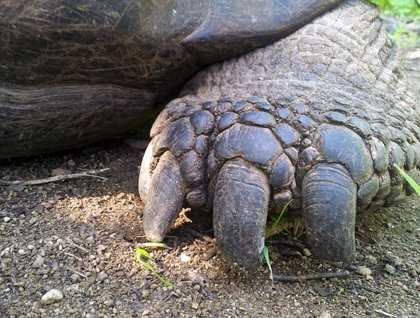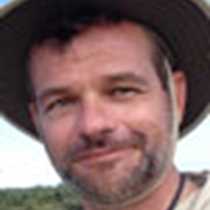The Bolivar Chanel waters that separate Fernandina from Isabela Islands are perfectly calm this morning. The ship is surrounded by the impressive and majestic outline of the great volcanoes that reign in this part of the archipelago. Our destination is precisely at the junction of Darwin and Alcedo volcanoes. It’s a bay of a V shape where the waves funnel into and break at the shore on a black sandy beach. The dune is covered with turtles’ nests. Urbina Bay’s shoreline had been redefined in 1954 when an uplifting raised the sea floor 20 feet up, and exposed corals, barnacles and some mollusks to the sun. This sandy bottom became a suitable ground for the land iguana to dig their burrows into. Add luxurious vegetation that surprisingly blooms into a salty and siliceous soil, and it’s clear they found a perfect habitat to maintain a healthy population. We also find a good number of giant tortoises in this green and improbable oasis. The first one we observed was under a poison apple tree, dedicating its time to swallowing the extremely toxic fruit for humans, but a delicacy for them. This is a land of reptiles: turtles at the sea, tortoises on the trail, marine iguanas on the shore, land iguanas under the bushes, lizards, snakes, and flocks of finches inhabit this uplifted new land of opportunity. As mammals, we are all happy to have a refreshing swim at the beach after such a hot walk.
In the afternoon we anchored at Tagus Cove, maintaining the tradition to find a harbor here dating from the whaling time. The graffiti painted into the tuff rock stands as a witness of the human presence here and its successive expeditions: whaling, exploring, scientific, fishing, and today – tourism. We first go snorkeling, and it becomes obvious that life could not be here if it weren’t for the ocean wealth. Penguins spear into a school of small fish and pick up their lunch. A cormorant bumps up at the surface with an octopus in its bill and dedicates himself to the killing before eating it. Turtles graze on the undulating meadows of algae. A sea lion goes straight forward into the blue for fish. The evidence of abundance and our dependence on the ocean is intense.
We finished the day at the top of the crater enjoying the sunset and comparing the arid land of lava with the marine life.
A great day of exploration!







